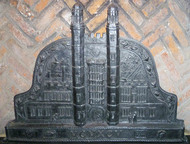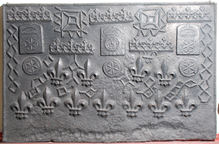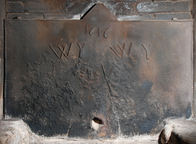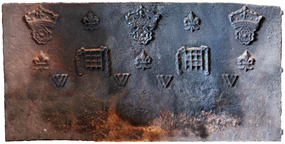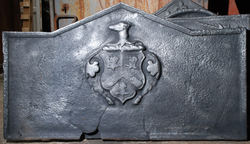-
1180
Description: Quasi-arched rectangular shape; parallel simulated twisted rope edging enclosing a border of lilies; pictorial representation of the facade and gatehouse towers of Eton College, between which is a clockface below crenellation; above left, two house martins flying; at ground level, ?four people (one of which is said to be Nigel Jaques, one of the masters) all standing on a plinth bearing, in the centre, the date MCMXCV between four small cartouches, of which to the left and nearest the date is a pack of playing cards; others bear the inscriptions, MCM and CofA (Charteris of Armisfield).
Notes: Designed by and made for Martin, Lord Charteris of Armisfield, Provost of Eton (1978-91).
Inscription: MCMXCV
- Decoration tags:
- quasi-arched rectangular (shape)
- rope (edging)
- whole carved pattern
- pictorial
- architectural
- monogram
- text
- animals
- humans
Manufactured: in 1995 in England.
Current location: Eton College, Eton, Berkshire, England.
Museum number: FDA-A.298-2013 (part of the Eton College museum group)
- Attached to series:
- Martin Charteris firebacks
-
371
Description: Rectangular; twisted rope edging (top and sides); top row, two square-within-a-square arrangements of twisted rope between three stamps formed of Gothic tracery cresting; 2nd row, two more tracery cresting stamps (the one on the right over stamping a fleur-de-lys) between two crowned, star-embossed butter mould stamps with a crowned rose-en-soleil stamp in the middle; 3rd row, three star-embossed butter mould stamps with two pairs of fleurs-de-lys between them; bottom row, seven fleurs-de-lys; plus interspersed short rope lengths, and a vertical, double zig-zag arrangement of rope lengths on each side.
Notes: The rose-en-soleil was the badge of King Edward IV and, thus, a Yorkist symbol. Many of the stamps employed on this fireback are seen, with other stamps, on a wide variety of firebacks, suggesting a common source; similar gothic tracery stamps can be seen as pierced cresting on a rare late-Medieval, wooden Easter sepulchre at the redundant church of St Michael at Cowthorpe, North Yorkshire. Another fireback with an almost identical arrangement of the same stamps has also been noted (no. 713).
- Decoration tags:
- rectangular (shape)
- rope (edging)
- simple stamps
- carved stamps
- heraldic
- objects
Manufactured: in the mid to late 16th century possibly at Pounsley Furnace, Framfield in the Weald area of England.
Current location: Anne of Cleves House, Southover High Street, Lewes, East Sussex, England.
Museum number: LH000.940 (part of the Sussex Archaeological Society museum group)
-
471
Description: Rectangular with small central triangle on top; twisted rope edging (top and sides) and across base of triangle; top centre, date, centrally positioned above the separated pairs of initials, WY; below and right of centre, rope saltire; bottom centre, a hole apparently puncturing the plate from behind.
Notes: The initials are those of William Yalden (1580-1659), an ironmaster who was active in north-west Sussex and south-west Surrey where this and other similar firebacks have been noted. The saltire is likely to have had an apotropaic purpose. Although undoubtedly connected with the builder of the house wherein it rests, the fireback pre-dates the building, which was erected in 1640.
Inscription: 1616 / WY WY
- Decoration tags:
- rectangular with triangular arch (shape)
- rope (edging)
- simple stamps
- individual letters
- individual numbers
- apotropaic
- text
Manufactured: in 1616 in the Weald area of England.
Current location: in private hands, Lodsworth, West Sussex, England.
- Attached to series:
- William Yalden series
- Date & initials firebacks
-
1222
Description: Rectangular shape; no edging; symmetrical arrangement of four stamps: across the top, three crowned roses with a fleur-de-lys between each pair; across the middle, three fleurs-de-lys with a chained portcullis between each pair; below and in the spaces between the fleurs and portcullises, four letters W.
Notes: The letter W may have an apotropaic significance; the stamps have not been recorded on other firebacks.
Inscription: W W W W
- Decoration tags:
- rectangular (shape)
- none (edging)
- carved stamps
- heraldic
- apotropaic
- text
- objects
Manufactured: in the late 16th century possibly in the Weald area of England.
Current location: Great Dixter, Northiam, East Sussex, England.
- Attached to series:
- Miscellaneous royal firebacks
-
622
Description: Rectangular with pediment arch; ovolo-moulded edging; central shield, mantling and crest: per pale, on a chevron between three heads erased, as many mullets; crest: a hind’s head erased.
Notes: No secure identification of the arms. The blazon may be: Per pale on a chevron between three ?gryphons’ heads erased, three mullets (the tinctures are not known). The crest appears to be a hind's head erased. Sold at Christie's Masters and Makers auction, 30 November 2010, lot 531 (£688).
Copies of this fireback are known.
Arms: Not known
- Decoration tags:
- rectangular with triangular arch (shape)
- ovolo (edging)
- carved pattern panels
- armorial
Manufactured: in the late 16th to early 17th century possibly in the Weald area of England.
Current location:, not known.
- Attached to series:
- Personal armorial firebacks
